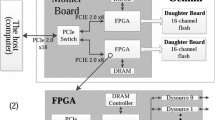Abstract
The existing NAND flash memory file systems have not taken into account multiple NAND flash memories for large-capacity storage. In addition, since large-capacity NAND flash memory is much more expensive than the same capacity hard disk drive, it is cost wise infeasible to build large-capacity flash drives. To resolve these problems, this paper suggests a new file system called NAFS for large-capacity storage with multiple small-capacity and low-cost NAND flash memories. It adopts a new cache policy, mount scheme, and garbage collection scheme in order to improve read and write performance, to reduce the mount time, and to improve the wear-leveling effectiveness. Our performance results show that NAFS is more suitable for large-capacity storage than conventional NAND file systems such as YAFFS2 and JFFS2 and a disk-based file system for Linux such as HDD-RAID5-EXT3 in terms of the read and write transfer rate using a double cache policy and the mount time using metadata stored on a separate partition. We also demonstrate that the wear-leveling effectiveness of NAFS can be improved by our adaptive garbage collection scheme.
Similar content being viewed by others
References
Samsung Electronics Co, NAND Flash Memory. http://www.sec.co.kr/
Needham & Company, LCC (2005) NAND vs hard disk drives: hype, myth and reality
Samsung Electronics Co, Solid state drive. http://www.sec.co.kr/
Henessy JL, Patterson DA (2002) Computer architecture a quantitative approach, 3rd edn. San Mateo, Morgan Kaufmann
Park SO, Kim SJ (2009) HDD-RAID5-EXT3: a disk-based RAID5 file system for Linux based on EXT3. Internal report, mobile and embedded system lab, Aug 2009
Johnson MK, Hat R Inc, Red hat’s new journaling file system: ext3. http://www.redhat.com/support/wpapers/redhat/ext3/ext3.pdf/
Woodhouse D, Hat R Inc, JFFS: the journaling flash file system. http://linux-mtd.infradead.org/~dwmw2/jffs2.pdf/
Aleph One Company, YAFFS yet another flash filing system. http://www.yaffs.net/
Park SO, Kim SJ (2007) A fast mount and stability scheme for a NAND flash memory-based file system. J KIISE: Comput Syst Theory 34(12):683–695
Lim SH, Park KH (2006) An efficient NAND flash file system for flash memory storage. IEEE Trans Comput 55(7):906–912
Park SO, Kim SJ (2009) An efficient multimedia file system for NAND flash memory storage. IEEE Trans Consum Electron 55(2):139–145
Lee TH, Park SH, Kim TH, Lee SG, Lee JK, Chung KD (2005) RFFS: design of a reliable NAND flash file system for embedded system. KIPS Trans: Part A 12(7):571–582
Lee HG (2010) High-performance NAND and PRAM hybrid storage design for consumer electronics. IEEE Trans Consum Electron 56(1):112–118
Park S-H, Lee T-H, Chung K-D (2006) Design of a NAND flash memory file system to improve system boot time. Int J Inf Proces Syst 2(3):147–152
Cooke J, Micron Technology Inc (2006) Flash memory 101: an introduction to NAND flash. CommDesign, Mar 2006
Blackwell T, Harris J, Seltzer M (1995) Heuristic cleaning algorithms in log-structured file systems. In: Proceedings of the 1995 winter Usenix
NAND Simulator, Memory technology device (MTD) subsystem for Linux. http://www.linux-mtd.infradead.org/
IOzone Organization, IOzone filesystem benchmark. http://www.iozone.org/
Kawaguchi A, Nishioka S, Motoda H (1995) A flash-memory based file system. In: Proceedings of USENIX technical conference, pp 155–164
Rosenblum M, Ousterhout JK (1992) The design and implementation of a log-structured file system. ACM Trans Comput Syst 10(1):26–52
Kim JK, Park SM, Kim CK (2002) A ranking cleaning policy for embedded flash file systems. KIPS Trans: Part A 9(4):399–404
Lee TH, Lee SG, Chung KD (2005) A plain cleaning policy for embedded flash file system. In: Proceedings of the Korea computer congress 2010 (KKC 2010), vol 32(2), pp 778–780, Nov 2005
Author information
Authors and Affiliations
Corresponding author
Rights and permissions
About this article
Cite this article
Park, S.O., Lee, Y.S. & Kim, S.J. A high performance NAND array file system based on multiple NAND flash memories. J Supercomput 64, 492–506 (2013). https://doi.org/10.1007/s11227-011-0714-1
Published:
Issue Date:
DOI: https://doi.org/10.1007/s11227-011-0714-1




